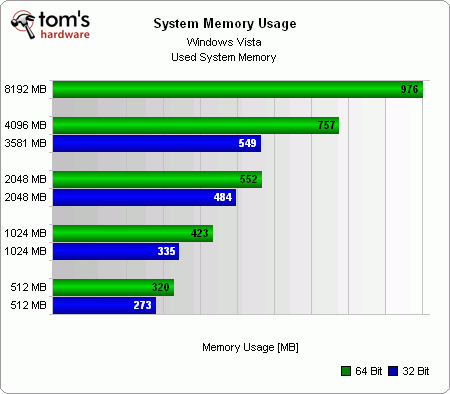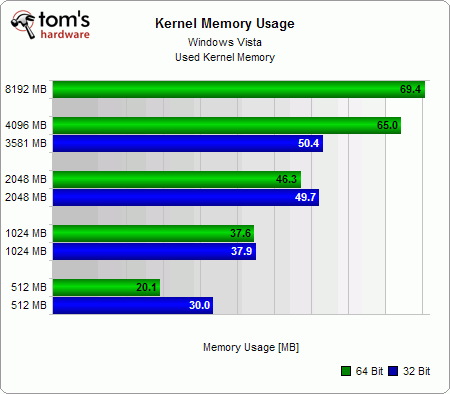Vista Workshop: More RAM, More Speed
More RAM - Additional Memory Used By Windows
When reserving memory, Windows Vista goes by the amount of RAM installed in the computer. Unlike previous versions, Vista will automatically use more memory for the system if there is more available. The result is that fewer files have to be written to the page file on the slow hard drive, giving the system a noticeable performance boost.
The following diagram clearly shows that Windows Vista will reserve more memory for the system when there is more RAM installed.
We can also see that the 64 bit versions take up quite a bit more memory as well. Again, the explanation is very simple: all of the variables are no longer only 32 bits long, but 64 bits instead. Typically, this makes applications between 20% and 40% larger, which consequently results in a higher memory footprint as well. File formats such as music files or videos are not affected by this.
The upshot is that it doesn't make sense to install a 64 bit version of Vista in order to better utilize 4 GB of memory simply because the 32 bit version would only recognize 3.5 GB. The problem is that while it is true that you would "gain" the missing memory, you would also immediately lose it to the system due to the 64 bit version's larger memory footprint. Thus, using a 64 bit version really only makes sense with larger memory sizes.
Get Tom's Hardware's best news and in-depth reviews, straight to your inbox.
Current page: More RAM - Additional Memory Used By Windows
Prev Page Supported Memory Size - Server Operating Systems Next Page Does No Swap File Equal Better Performance?-
trifler We need to see benchmarks comparing Vista with 2MB, 4MB, and 8MB. I can't tell my boss that the new high-end computers should have 8MB without some numbers.Reply -
I think meant GB not MB there Trifler... 8MB of ram is not very much... and a "high-end computer" should have at least 2GB of RAM for a 32-bit system, and is OS dependant for 64-bit systems... vista depends on the ver you use as to how much ram is max.Reply
I have 1 GB of RAM and am using 80% after a normal boot (plus a few non-essential apps... but they make doing things easier -
SkyPRZ There is a "test setup" but not followed by any test but directly by the conclusion.Reply
Did I miss something?
Nevertheless I've already built a system with Vista 64 & 8GB ram few weeks ago and wanted the test to comfort decisions I made. -
master9716 with 2 gigs of ram my 64bit runs ultra fast compared to 32bit , I have 3 hdds quad 6600. it should be the otherway around though . On my laptop with 1.5 gigs vista basic runs prety bad I will reinstall see what happens . We need to see some load time benchmarks !!! eventhough this is an old articleReply -
Darthb0b0 on page 7, how are you changing the amount of ram a particular app is using? is this only applicable to 64-bit windows, or could you also change this with 32-bit?Reply -
Darthb0b0 One other thing. on page 5 you say that w/4gb of ram it has no benefit to go to 64 bit due to the larger memory foot print required - essentially eating up the extra memory. The extra system memory used is 757 - 549 = 208. Yet the extra addressable memory gained is 4096 - 3581 = 515. The difference is still a net gain of 307mb of ram. Or am I missing something?Reply
Also, is the reason that only 3.5GB is available in the 32-bit environment due to the 512mb video card and MMIO? If so, what will happen in a 32 or 64 bit system if you have a video setup with 2gb of video ram? Will you only have 2GB of main memory available? -
Darthb0b0 One answer found:Reply
Significant chunks of address space below 4GB (the highest address accessible via 32-bit) get reserved for use by system hardware:
• BIOS – including ACPI and legacy video support
• PCI bus including bridges etc.
• PCI Express support will reserve at least 256MB, up to 768MB depending on graphics card installed memory

